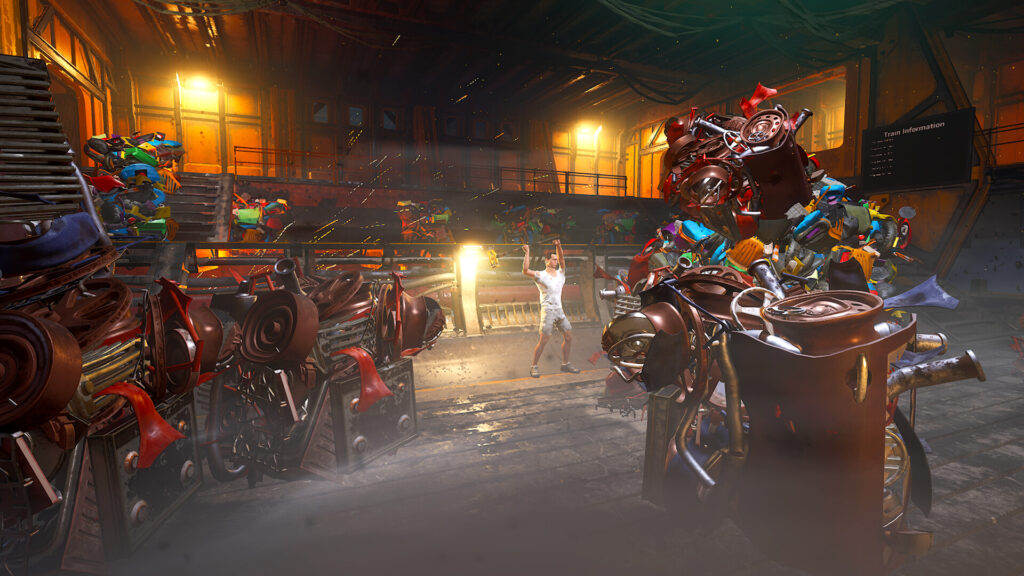Based on my brief experience with it, Enginefall’s strongest point is that it lacks the instantly recognizable characteristics of survival, extraction, and battle royale games that it seems to be emulating. You might not get as far as you would in other games right out of the gate if you have a Tarkov or Fortnite experience. The quantity of small things you’ll need to learn to make wise decisions is daunting, yet this early learning curve is also a result of creative systems that produce a faster and more hazardous pace than others.
The beginning of each Titan Train run is the same: raiders, either alone or in groups of up to five, begin at the rear of the enormous city-state on rails. Each group must run, craft, climb, and shoot their way to the engine at the front of the train as soon as the timer goes off. Everything is extremely disorganized from beginning to end, which is entertaining and captivating but also annoying and perplexing.
Right from the outset, my five-person party filled our pockets with as many metal and plastic scraps we could discover lying about the ground. These materials are crucial for building bases and starting gear. We began by breaking up bundles of ceramic material into smaller, more manageable bits and using sledgehammers to smash the plastic off the long plastic seats that were mounted on the train’s sides. It took more strokes than anticipated for them to break off entirely, but fortunately, each swing only added a bunch of plastic to your inventory rather than scattering confetti on the ground for you to clean up after.
Breaking down this raw material made me feel really vulnerable, and I could have easily become a victim if I hadn’t had a few others with me. Solo players would probably need to approach this first section more covertly, possibly losing out on early gearing up entirely.
Finding a comfortable train cabin, strengthening the doors, and claiming it as our first of probably multiple forward operating bases—where we can store our loot and update our equipment in relative safety—was our first agenda item, which was planned by Shaun “Flak” Stiglingh, one of my team’s developer-sherpas. Our second guide, Fred Richardson, CEO of Red Rover Interactive, arranged our supplies while he led the rest of us out to find another useful application for our sledgehammers. He beat up other raiders and took their belongings.
We eventually gathered enough items to equip ourselves with some armor and a plan for the remainder of our expedition. While creating menus and systems is quite simple and serviceable, understanding how to prioritize what you research and construct first to gain the most advantage looks like a difficult effort that can only be accomplished by a great deal of trial and error. This didn’t take long. This time, I was content to let Flak take care of it and lay out our plan for getting to the engine room.
We must obtain keys that allow us to enter higher-class train carriages to reach the front of the train (we begin in third and must eventually advance via second, first, and conductor classes). We discover these keys in the train cars that we already have access to, whether they are in the wallets of our rival raiders, among scraps, or among riches in the various boxes hidden in every corner and cranny. We only needed to make it to the transfer gate without getting derailed because, fortunately, Fred’s prior hammer party had produced a second-class ticket.
He and Fred concluded that the lower decks would be the ideal option, noting that every train car had multiple connecting pathways, each with its own advantages and disadvantages. Although the walkways are small and one fall would undoubtedly kill you, traveling in rafters far above the main levels of the cars would keep you off the ground. Certain carriages allow you to exit the train entirely, exposing you to the hostile environment of the surrounding wasteland. However, they also provide you with some lethal shortcuts that, if you survive, would undoubtedly help you make up some ground. The lower decks, where the train’s exhaust is poured through, are a similar story.
We had the necessary masks after a bit more farming of people and things. As expected, everything went rather well as we descended beneath the lower tunnels. We drove the gassy express lane straight through third class and smoothly transitioned into the next zone, albeit occasionally we would have to pop back up to the main level to transfer cars.
I encountered a lot of conflict in the second-class car, primarily from the servers. This was the biggest stress test that Red Rover Interactive had ever conducted. Because I couldn’t tell if my escape during my time actually occurred in front of my partymates (it didn’t), I don’t blame them for my fate, which found me rubberbanding during stressful situations like firefights and while gathering a treasure trove of goodies from a resource drop that would ultimately cause my death. I was stuck in a death screen for a considerable amount of time, unable to do anything in the game while the chaos played out right in front of me.
Even while I was grateful for the chance to experience what it must have been like to be one of those spirits on the train in Final Fantasy 6, I was unable to witness nearly all of the antics that took place in the 2nd Class cars. I eventually recovered and was able to function again, just in time for a last-ditch rush to the First Class section. As the lower-class cars gradually get permanently walled off, all survivors are forced to move up the train or risk being crushed by the class barriers, a mechanic akin to a Fortnite storm ring. What a metaphor.

